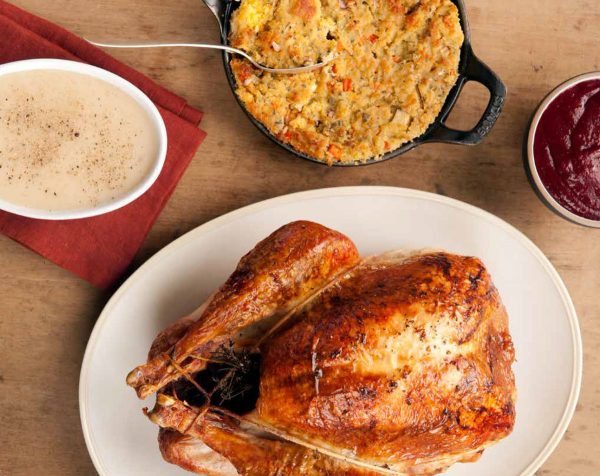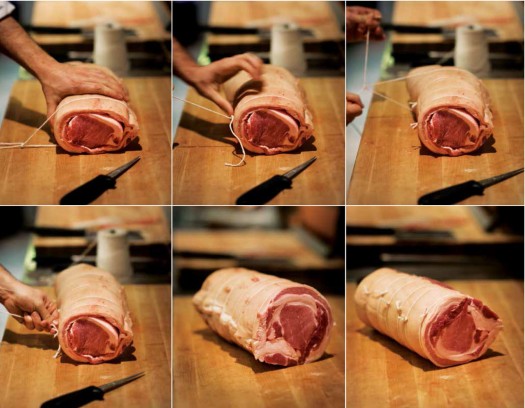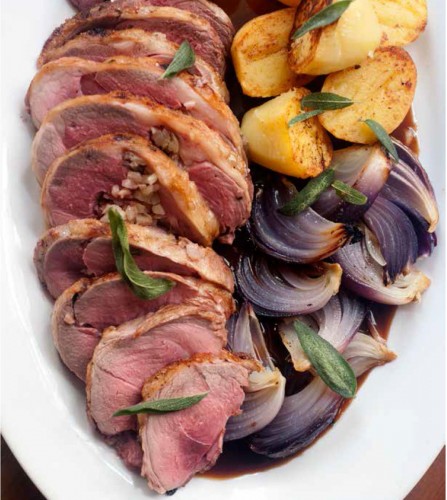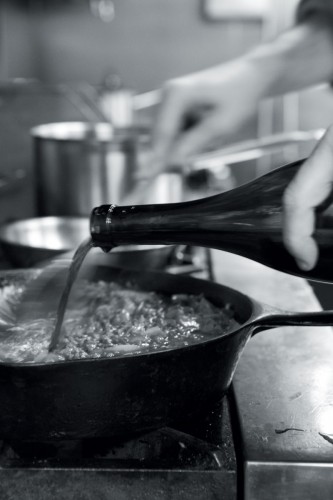Holiday Recipes from Rizzoli: The Main Course
October 28, 2014
As we creep closer and closer to the holiday season, it’s time to start thinking about what you’ll serve your guests this Thanksgiving and beyond. Whether you’ll make a traditional turkey or choose to break away from the holiday norm, Rizzoli has tons of great recipes and entertaining ideas for you to follow.
Enjoy these MAIN COURSE recipes below, or visit News & Publicity page for recipes for Appetizers, Side Dishes, Vegetarian options, Desserts, Wine & Cocktails, and a New Year’s Lobster Fest. You can also visit the Food & Wine section of our website for plenty of inspiring cookbooks to spur your creativity.
Slow Roasted Turkey with Simple Gravy
(picture at top)
“When it comes to cooking turkey, I take a traditional approach. This simple recipe will give you a great-tasting bird every time. Spend the extra money for a quality bird from a local farm, and you’ll really taste the difference.”
–From The New England Kitchen
Serves 8 to 10
1 (12-pound) turkey, innards removed, wings removed and reserved for the gravy below
1 recipe (about 1 gallon) Brine (recipe follows)
2 sprigs fresh rosemary
2 garlic cloves, crushed
1/2 cup (1 stick) unsalted butter
6 fresh sage leaves
Kosher salt and freshly ground black pepper
Simple Gravy (recipe follows)
In a container large enough to hold the turkey snugly, pour the brine over the bird and let sit for at least 2 hours or up to 6 hours. (If brining longer than 2 hours, place the container in the refrigerator. Bring the turkey to room temperature before roasting.) Drain the turkey well and pat it dry. Discard the brine.
Preheat the oven to 450°F.
Fill the turkey breast cavity with the rosemary and garlic and truss the turkey (see page 179). Place it on a roasting rack in a roasting pan. Melt the butter with the sage leaves and brush it all over the outside of the turkey. Season the turkey aggressively with salt and pepper and place it in the oven.
Roast the turkey for 5 minutes, then rotate the pan 180 degrees and cook for another 5 minutes. Brush the outside with more of the sage butter and lower the oven temperature to 300°F. Roast for 90 more minutes; every 20 minutes or so, brush a little more butter on the turkey. Check the internal temperature with a meat thermometer and remove from the oven when the thickest part of the breast meat registers 155°F. Cover loosely with foil and let rest for 30 minutes.
To serve, slice the turkey breast off by cutting down the middle of the backbone, starting with the blade against the bone. Remove both breasts from the rib cage, doing your best to keep the skin intact. Cut both breasts into slices and arrange on a large platter. Remove the legs, separate the thighs and drumsticks, and place on the platter. Serve with the gravy alongside.
Simple Gravy
1/4 cup canola oil
2 wings from the turkey
1 large shallot, thinly sliced
1/4 cup unsalted butter
1/4 cup all-purpose flour
3 cups Chicken Stock
2 sprigs fresh thyme
2 bay leaves
Kosher salt and freshly ground black pepper
1 teaspoon sherry vinegar
In a large heavy saucepan, heat the oil over medium-high heat. Add the turkey wings and cook until they start to brown, about 4 minutes per side. Add the shallot and sauté until it begins to color, another 4 to 5 minutes. Remove from the heat and drain off any excess fat. Transfer the wings and shallot to a plate. In the same pan, melt the butter and stir in the flour; scrape the bottom of the pan so that it doesn’t burn. Whisk in the stock and keep whisking until it comes to a simmer; add the cooked wings, shallots, thyme, and bay leaves. Lower the heat and simmer gently for 30 minutes, stirring frequently to keep the gravy from burning.
Remove from the heat, strain through a fine-mesh sieve, and discard the solids. Season with salt, pepper, and vinegar. Serve warm or refrigerate in an airtight container until ready to use (rewarm in a clean saucepan over medium-low heat, stirring frequently).
Brine
I like this basic brine for leaner meats such as pork and poultry. It can add great moisture and flavor to the finished product. (I don’t usually brine beef, as it has a higher fat content. I turn to rubs and marinades for fattier cuts of meat.) This brine recipe can easily be halved or doubled, depending on the size of the cut of meat you are brining.
To use the brine, submerge the meat in the brine and let sit for 2 to 4 hours. (If longer than 2 hours, place container in the refrigerator.) Remove the meat and air-dry the meat or poultry on a plate for several hours in the refrigerator before cooking.
Makes about 1 gallon
1/2 cup sugar
1 cup kosher salt
2 garlic cloves
1 sprig fresh thyme
1 sprig fresh rosemary
1 tablespoon mustard seeds
1 tablespoon chile flakes
1 small Spanish onion, cut in half
10 cups ice
In a large stockpot, combine all of the ingredients except for the ice, add 2 cups water, and bring to a boil.
Put the ice in a container that is large enough to hold the poultry or pork; once the brine has come to a boil, pour it over the ice. (The ice will cool down the brine quickly and dilute it.)

Arista in Porchetta (Boneless Pork Roast)
“Porchetta is traditionally a seasoned whole suckling pig that is slowly roasted until the meat is tender and the skin is crisp, but these days it is frequently made with just the loin and belly of a larger pig. Porchetta hails from central Italy, where at outdoor events, carts often sell succulent sandwiches made of thick slices of porchetta on crusty rolls. The pork loin is brined for 24 hours and the pork belly is seasoned and then refrigerated for 8 hours. A convenient way to handle this is to begin brining the loin the morning of the day before you wish to cook the porchetta, and then season the pork belly that evening and refrigerate it overnight. In a pinch, you can brine the loin overnight only, but the longer soaking time increases flavor and tenderness.”
–From How To Eataly
Serves 4 to 6
1/4 cup sugar
1 1/2 cups fine sea salt, plus more for seasoning belly
About 1 gallon water
4 pounds boneless pork loin, sinew and fat trimmed
4 pounds boneless pork belly with skin
Freshly ground black pepper to taste
3/4 cup fennel seeds
3/4 cup black peppercorns
2 tablespoons minced garlic
Place the sugar and ½ cup salt in a container large enough to hold the pork loin in the brine. Bring a large pot of water (about 1 gallon) to a boil and pour into the container. Whisk until the salt and sugar are dissolved. Add a generous amount of ice to cool the water—you want enough liquid to fully submerge the loin. Place the loin in the cold brine (add water to cover if needed) and refrigerate for 24 hours.
In a spice grinder, grind the fennel seeds and black peppercorns. Combine with the remaining 1 cup salt. Reserve about half of this spice mixture in a small bowl and set aside.
Season the pork belly with the other half of the spice mixture; discard any that isn’t used. Cover the pork belly and refrigerate for at least 8 hours.
When you are ready to roast the porchetta, preheat the oven to 350ºF. Combine the reserved spice mixture with the minced garlic and stir to combine.
Remove the loin from the brine and pat dry. (Discard the brine.) Completely coat the loin and the pork belly with the garlic spice mixture. Use some of the reserved rub, if needed, to cover all of the meat’s surface area. Wrap the belly around the pork loin so that the loin is completely covered. Truss the meat with twine, tying knots about 1 inch apart. (The easiest way to do this is to start in the middle of the porchetta and work your way to the ends.) Place the porchetta on a rack set in a roasting pan. Place in the preheated oven and cook until the middle of the pork loin reaches an internal temperature of 138ºF and the skin is crispy, which will likely take at least 1 hour 15 minutes but may take up to 2 hours. Allow the porchetta to rest before slicing.

Sage & Fennel-Stuffed Roasted Leg of Lamb
“This comforting dish is a bit of a challenge to make at home but is well worth the effort. Try it a few times and you’ll become an expert at tying lamb legs. The humblest cuts of lamb, like the leg, shank, and shoulder, can be the most flavorful. At Lineage, we roast lamb legs in the wood-burning oven and, they have one of the most soul-warming aromas.”
–From The New England Kitchen
Serves 6 to 8
1 large bulb fennel, top cut off
2 tablespoons canola oil
6 large fresh sage leaves, finely chopped, stems reserved
Grated zest of 1 lemon (about 1 packed tablespoon)
Kosher salt and freshly ground black pepper
1 (5- to 6-pound) lamb leg, bone removed
1/4 cup extra-virgin olive oil
2 garlic cloves, thinly sliced
Core the fennel and cut it into 1⁄4-inch pieces. In a large sauté pan, heat the canola oil over medium heat and add the fennel. Cook until it’s just turning translucent, 5 to 6 minutes. Remove from the heat and add the sage and lemon zest. Season the filling with salt and pepper and let cool to room temperature.
While the fennel is cooling, unroll and lay the lamb leg flat so that the inside of the leg is exposed. Remove any large pieces of extra fat or sinew, and trim so that the meat is an even thickness. This might require cutting thicker pieces to butterfly them open or using a meat mallet to pound areas to make them thinner. The lamb should be 1 to 1 1⁄2 inches thick.
Season the inside of the leg with salt and pepper and spread the fennel stuffing over the lamb, leaving about a 2-inch border around the edges. Carefully roll the lamb into a cylinder; the roast should be even all the way across. Using butcher’s twine, tie the roast at 5 or 6 evenly spaced intervals.
Preheat the oven to 325°F.
In a small saucepan, heat the olive oil over medium heat; add the garlic and sage stems and cook until the garlic is lightly cooked, about 3 minutes. Remove from the heat and let cool to room temperature.
Place the lamb leg on a roasting rack and brush with the olive oil (let a couple of pieces of garlic and sage stick to the outside). Season the outside of the leg liberally with salt and pepper and place in the oven. Roast for about 1 hour and 30 minutes. (The time may vary depending on the thickness and size of your roast.) Check the internal temperature with a meat thermometer; the center should read 140°F. Let the lamb rest for 20 minutes before slicing.

Cottage Pie
“Shepherd’s pie is all about lamb (shepherds flock sheep after all!). While we love lamb, we’re even bigger fans of cottage pie. To be honest, we’re not really sure what cottages have to do with cows, but nevertheless we love the classic combination of flavorful minced beef topped with rich mashed potatoes.”
–From The Fat Radish Kitchen Diaries
Serves 4
Coarse salt
3 baking potatoes, peeled and cut into 1-inch pieces
4 tablespoons butter
1 cup cream
3 tablespoons olive oil
1 pound ground beef
Freshly ground black pepper
1 carrot, peeled and finely diced
1 celery stalk, finely diced
1 yellow onion, finely diced
1 bay leaf
1 teaspoon minced thyme
ó cup dry red wine
1 (15-ounce) can diced tomatoes
Preheat oven to 425ºF.
Bring a large pot of salted water to a boil and add the potatoes. Boil until the potatoes are very tender, about 25 minutes. Drain the potatoes and return them to the pot. Add the butter and cream, then mash with a potato masher. Season the mash to taste with salt and set aside.
Meanwhile, place the oil in a large cast-iron skillet set over medium-high heat. Add the beef and season with a large pinch of salt and a few grinds of black pepper. Cook the beef, stirring now and then, until browned, about 15 minutes. Using a slotted spoon, transfer the meat to a bowl and set it aside. Place the carrots, celery, onion, bay leaf, and thyme in the skillet and cook until the vegetables are softened and a bit browned, about 15 minutes. Return the beef to the skillet and add the wine and the tomatoes. Bring the mixture to a boil, lower the heat to a simmer, and cook until the mixture is happy, about 15 minutes. Season to taste with salt and pepper.
Spread the mash on top of the meat mixture and transfer the skillet to the oven. Bake until the top is a bit browned, about 15 minutes. Serve immediately.